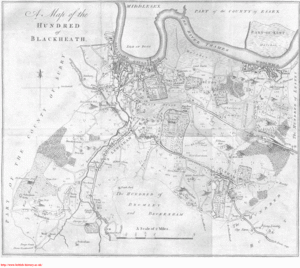Hundred of Blackheath, Kent
Blackheath was an ancient hundred in the north west of the county of Kent, England. Its area has been entirely absorbed by the growth of Greater London; the name "Blackheath" now refers to a locality of SE London.[1] Its former area now corresponds to the Royal Borough of Greenwich, the London Borough of Lewisham and part of the London Borough of Bromley.
| Blackheath | |
|---|---|
 Map of the Hundred of Blackheath, published in 1797 | |
| Area | |
| • 1831 | 12,650 acres (51 km2) |
| • 1887 | 17,316 acres (70 km2) |
| Population | |
| • 1851 | 121,753 |
| • 1887 | 234,987 |
| History | |
| • Created | in antiquity |
| • Abolished | 1889 |
| • Succeeded by | various, see text |
| Status | hundred |
| • HQ | Blackheath |
History
The name is first recorded as Blachehedfeld in 1166, meaning dark-coloured heathland.[1] The open space at Blackheath was the site of hundred meetings.[1] In the Domesday Book of 1086 it is recorded as the hundred of Grenviz (Greenwich),[2] which was part of the lathe of Sutton at Hone.[3] The hundred contained the parishes of Charlton, Chislehurst, St Paul and St Nicholas Deptford, Eltham, Greenwich, Kidbrooke, Lee, Lewisham, Woolwich and Mottingham.
The northern boundary with the Becontree hundred of Essex was mainly the River Thames; however there was also a short land boundary as the parish of Woolwich included two small exclaves north of the river,[4] totalling 402 acres (1.6 km2).[5] Also to the north along the river was a short boundary with the Isle of Dogs and the Tower division of the Ossulstone hundred of Middlesex.[6] In the west it bordered the Brixton hundred of Surrey. Within Kent, it was bounded by the hundreds of Bromley and Beckenham to the south, Ruxley to the south east and Lesnes to the east.[6]
In 1831, the hundred occupied 12,650 acres (51 km2).[7] The parishes of St Paul and St Nicholas, Deptford and the parish of Greenwich were included in the Metropolitan Police District by the Metropolitan Police Act 1829, and in 1840 the rest of the hundred was included by the Metropolitan Police Act 1839.
The population is recorded as 121,753 in 1851 and 187,696 in 1861.[8] In 1887 the hundred is recorded as occupying an area of 17,316 acres (70 km2), with a population of 234,987.[9]
Replacement
The hundreds of England declined in administrative significance because of the rise of various ad hoc boards which took over administrative functions. In 1855, most of the hundred (except Chislehurst and Mottingham) was included in the area of the Metropolitan Board of Works by the Metropolis Management Act 1855. The hundred fell into desuetude when the area (except Chislehurst and Mottingham) became part of the County of London in 1889. The entire area has formed part of Greater London since 1965.
In 1894 and 1900 all local government functions were effectively replaced by a system of districts, which were consolidated over time and finally replaced in 1965 by the London boroughs which are still in use today.
| Parish | District | London borough |
|---|---|---|
| Charlton | Metropolitan Borough of Greenwich | Greenwich |
| Chislehurst | Bromley Rural District | Bromley |
| Deptford St Nicholas | Metropolitan Borough of Greenwich | Greenwich |
| Deptford St Paul | Metropolitan Borough of Deptford | Lewisham |
| Eltham | Metropolitan Borough of Woolwich | Greenwich |
| Greenwich | Metropolitan Borough of Greenwich | Greenwich |
| Kidbrooke | Metropolitan Borough of Greenwich | Greenwich |
| Lee | Metropolitan Borough of Lewisham | Lewisham |
| Lewisham | Metropolitan Borough of Lewisham | Lewisham |
| Mottingham | Bromley Rural District | Bromley |
| Woolwich | Metropolitan Borough of Woolwich | Greenwich |
References
- Mills, A., Oxford Dictionary of London Place Names, (2001)
- British History Online - The Hundred of Blackheath
- Vision of Britain - Blackheath hundred
- British History Online - Map of Becontree Hundred, (1973)
- British History Online - The Origin of North Woolwich, (1973)
- British History Online - Map of Blackheath Hundred, (1973)
- Vision of Britain - Blackheath hundred - area (historic map)
- John Marius Wilson, Imperial Gazetteer of England and Wales, (1870-72)
- John Bartholomew, Gazetteer of the British Isles, (1887)